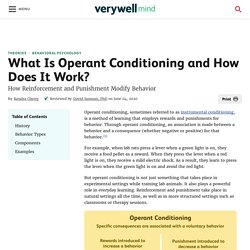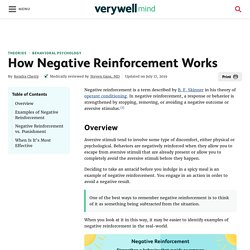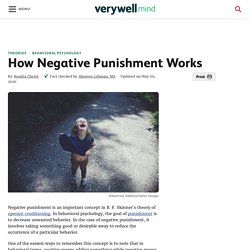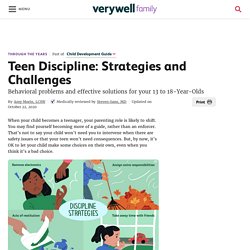

Can Teens & Parents See Eye to Eye? What Is Operant Conditioning and How Does It Work? Operant conditioning, sometimes referred to as instrumental conditioning, is a method of learning that employs rewards and punishments for behavior.

Through operant conditioning, an association is made between a behavior and a consequence (whether negative or positive) for that behavior.1 For example, when lab rats press a lever when a green light is on, they receive a food pellet as a reward. When they press the lever when a red light is on, they receive a mild electric shock. As a result, they learn to press the lever when the green light is on and avoid the red light. But operant conditioning is not just something that takes place in experimental settings while training lab animals.
The History of Operant Conditioning Operant conditioning was first described by behaviorist B.F. Through the first part of the 20th century, behaviorism became a major force within psychology. Early behaviorists focused their interests on associative learning. B.F. Skinner Operant Conditioning (Full video) Positive Reinforcement and Operant Conditioning. In operant conditioning, positive reinforcement involves the addition of a reinforcing stimulus following a behavior that makes it more likely that the behavior will occur again in the future.

When a favorable outcome, event, or reward occurs after an action, that particular response or behavior will be strengthened. One of the easiest ways to remember positive reinforcement is to think of it as something being added. By thinking of it in these terms, you may find it easier to identify real-world examples of positive reinforcement. Sometimes positive reinforcement occurs quite naturally. For example, when you hold the door open for someone you might receive praise and a thank you. Negative Reinforcement and Operant Conditioning.
Negative reinforcement is a term described by B.

F. Skinner in his theory of operant conditioning. In negative reinforcement, a response or behavior is strengthened by stopping, removing, or avoiding a negative outcome or aversive stimulus.1 Overview Aversive stimuli tend to involve some type of discomfort, either physical or psychological. Positive Punishment and Operant Conditioning. Positive punishment is a concept used in B.F.

Skinner's theory of operant conditioning. How exactly does the positive punishment process work? The goal of any type of punishment is to decrease the behavior that it follows. In the case of positive punishment, it involves presenting an unfavorable outcome or event following an undesirable behavior. When the subject performs an unwanted action, some type of negative outcome is purposefully applied.
The concept of positive punishment can be difficult to remember, especially because it seems like a contradiction. Examples You may be surprised to notice examples of positive punishment in your day-to-day life. Because you're late to work one morning, you drive over the speed limit through a school zone. How Negative Punishment Works. Negative punishment is an important concept in B.

F. Skinner's theory of operant conditioning. In behavioral psychology, the goal of punishment is to decrease unwanted behavior. In the case of negative punishment, it involves taking something good or desirable away to reduce the occurrence of a particular behavior. One of the easiest ways to remember this concept is to note that in behavioral terms, positive means adding something while negative means taking something away.
Examples of Negative Punishment Can you identify examples of negative punishment? After two children get into a fight over who gets to play with a new toy, the mother simply takes the toy away from both children.A teenage girl stays out for an hour past her curfew, so her parents ground her for a week.A third-grade boy yells at another student during class, so his teacher takes away his "good behavior" tokens that can be redeemed for prizes. Reinforcement vs Punishment Psychology [Examples] Reinforcement and punishment are often used as parenting tools to modify children’s behavior.
![Reinforcement vs Punishment Psychology [Examples]](http://cdn.pearltrees.com/s/pic/th/reinforcement-punishment-183049524)
Let’s review the difference between positive reinforcement and negative reinforcement, and the difference in outcomes between them. The Difference Between Positive And Negative Reinforcement In behavioral psychology, reinforcement is the introduction of a favorable condition that will make the desired behavior more likely to happen, continue or strengthen in the future1. Because the favorable condition acts as a reward, reinforcement is a reward-based operant conditioning. There are two types of reinforcement: positive reinforcement and negative reinforcement. These two types of reinforcement can be confusing because the technical terms used in psychology is often misrepresented in pop culture.
As technical parlance, positive refers to adding a factor while negative refers to removing a factor. But positive and negative do not represent the quality of the factor being added or removed. References. Discipline for Teens: Strategies and Challenges. When your child becomes a teenager, your parenting role is likely to shift.

You may find yourself becoming more of a guide, rather than an enforcer. That’s not to say your child won’t need you to intervene when there are safety issues or that your teen won’t need consequences. But, by now, it’s OK to let your child make some choices on their own, even when you think it’s a bad choice. Typical Teen Behavior Teens like to test the limits of their independence.1 So don’t be surprised when your teen argues with you when you say no, or when they go behind your back to do as they please.